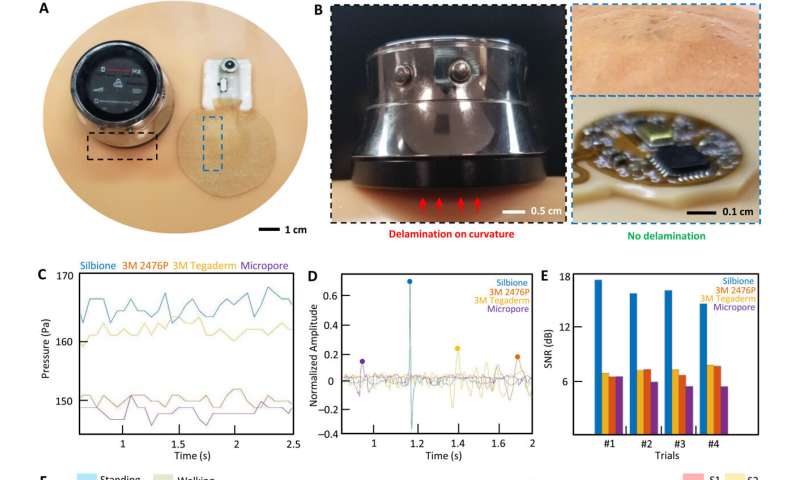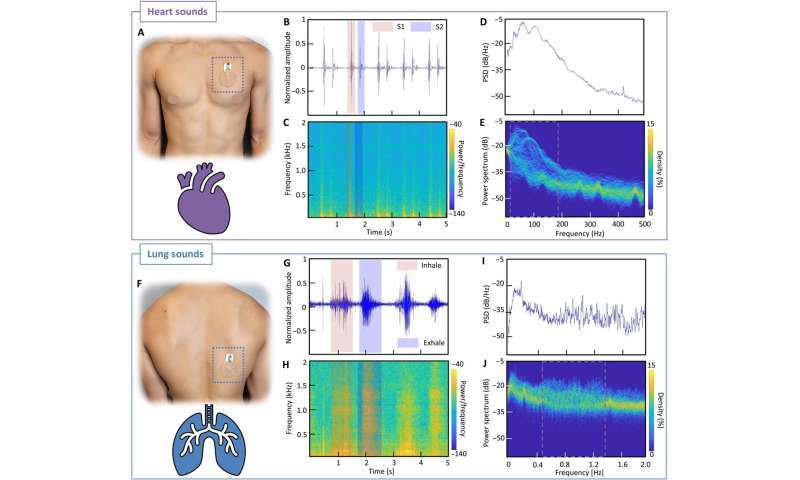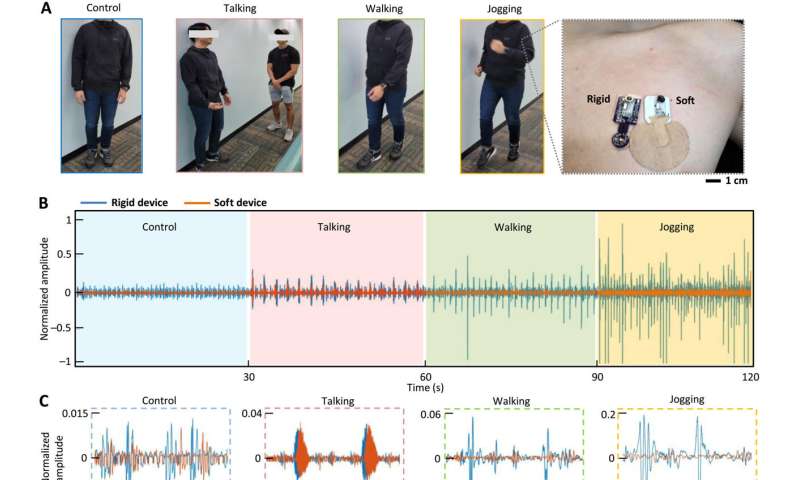le cipro

<img class="aligncenter" src="https://scx1.b-cdn.net/csz/news/800a/2022/a-soft-wearable-stetho.jpg"
alt="A soft wearable stethoscope designed for automated remote disease diagnosis"
title="Design, architecture, and mechanical properties of an SWS. (A) Schematic illustration of remote monitoring using the SWS, how to use green tea bags for puffy eyes with the zoomed-in photo of the device on the finger and the chest (bottom). Mobile device showing real-time graphs of cardiac and pulmonary auscultation data over 3 days (right) while doing daily activities without any contact (bottom right). (B) Exploded view of the SWS with multiple layers of deposited materials. (C) Image of the 20% stretched interconnects in the SWS. (D) Finite element analysis (FEA) results in (C). (E) Photo of the SWS with 180° bending. (F) FEA results showing cyclic bending from (E). (G) Schematic illustration of the flow for automated, objective diagnosis of diseases via machine learning in the SWS. Various real-time collected abnormal sounds go through preprocessing, machine learning, and classified results stream through the application installed in any mobile device. Credit: <i>Science Advances</i> (2022). DOI: 10.1126/sciadv.abo5867″ width=”800″ height=”529″>
Digital stethoscopes provide better results compared to conventional methods to record and visualize modern auscultation. Current stethoscopes are bulky, non-conformal, and not suited for remote use, while motion artifacts can lead to inaccurate diagnosis. In a new report now published in Science Advances, Sung Hoon Lee and a research team in engineering, nanotechnology, and medicine at the Georgia Institute of Technology, U.S., and the Chungnam National University Hospital in the Republic of Korea described a class of methods to offer real-time, wireless, continuous auscultation. The devices are part of a soft wearable system for quantitative disease diagnosis across various pathologies. Using the soft device, Lee et al detected continuous cardiopulmonary sounds with minimal noise to characterize signal abnormalities in real-time. The team conducted a clinical study with multiple patients and control subjects to understand the unique advantage of the wearable auscultation method, with integrated machine learning, to automate diagnoses of four types of disease in the lung, ranging from a crackle, to a wheeze, stridor and rhonchi, with 95% accuracy. The soft system is applicable for a sleep study to detect disordered breathing and to detect sleep apnea.
Auscultation in the field of medicine
Chronic obstructive pulmonary disease (COPD) and cardiovascular disease (CVD) are predominant factors of mortality worldwide. The two pathologies form an umbrella term for diseases of the heart and lung, leading to the malfunction and restricted blood flow during breathing. While approximately 80% of COPD mortality occurs in low-to-middle income countries due to healthcare inaccessibility, accurate auscultation can be helpful diagnose disease at an early stage and evaluate the treatment response. Similarly, heart sounds also facilitate diagnosis and the identification of vascular heart diseases.
Auscultation is the most basic and vital diagnostic method in medicine, due to its noninvasive, fast, informative and inexpensive use. Since most stethoscopes cannot record the detected sounds, the process can be limited via conventional stethoscopes, making it difficult to share the outcomes to record abnormalities. As a result, some of the critical respiratory and heart diseases can be misdiagnosed or underdiagnosed. Digital stethoscopes that assist auscultation in real-time can covert acoustic sounds to electrical signals to amplify inaudible sounds via acoustic stethoscopes. In this work, Lee et al introduced a soft wearable stethoscope system for ambulatory cardiomyopathy auscultation via a class of methods based on advanced electronics, flexible mechanics, and soft packaging for cardiovascular disease, and respiratory monitoring.

Device design of a soft wearable stethoscope (SWS)
The team collected the cardiorespiratory data accurately during daily activities to diagnose pulmonary abnormalities. They then improved the signal-to-noise ratio from the wavelet-denoised sound collection, to minimize circuitry and made the device more compact to train a machine learning model to accurately identify stridor, rhonchi, wheezing, and crackling lung sounds. Lee et al also developed a user-friendly mobile device application to record heart and lung sounds, and uploaded the information remotely and securely. They formed the miniaturized, soft wearable system for remote patient cardio-pulmonary auscultation with exceptionally small and mechanically flexible devices, for flexible skin integration, and self-assisted auscultation to facilitate remote continuous monitoring without patient-physician physical interactions. The elastomeric enclosure maintained an inner silicone gel to assist skin contact, and included a thin, conductive hydrogel-coupled layer to auscultate cardiac and respiratory activities. The setup included multiple layers of soft materials and electronic components, including a microphone sensor, rechargeable battery, and thin-film circuits with a blue-tooth low-energy unit for wireless data transmission. The system maintained a microelectronic mechanical system microphone for sound recording, allowing the team to convert the sound collected from the microphone to digital signals via an analog-to-digital converter streamlined via the wireless chip for data processing. The fully portable stethoscope offered a unique opportunity to remotely monitor the digital health.
Conventional stethoscope vs. the digital stethoscope

The team sought to maintain appropriate contact of the wearable microphone system to the skin. When compared to the commercial stethoscope, the thin and flexible digital stethoscope formed conformable contact for high-quality sound recording. Lee et al conducted experiments to compare the sound recording performance between conventional vs. digital stethoscopes, in which healthy subjects walked or stood with the device mounted on the chest and recorded sounds every five minutes. The device further demonstrated water-proof capabilities and breathability, for long-term use.
Detecting cardiac sounds in daily life and introducing a denoising algorithm for automated disease diagnosis
Since daily activities have diverse sources of noise, and can negatively affect recording sounds with a conventional stethoscope, clinicians perform auscultations in patients in a resting state. Lee et al demonstrated the performance of a digital stethoscope to regulate motion artifacts relative to the skin-contact quality by exploring a range of scenarios in which subjects mimicked a variety of real-life situations to show the influence of the measured sound quality. While the soft device allowed efficient sound recording, conventional stethoscope-like devices caused low-quality recordings of the heart and lung sounds. The team used additional filtering of the first-level cut-off frequencies to remove unwanted high-frequency noise.

The researchers studied wavelet transformation of heart, lung sound signals and noise filtering to capture sounds of the body and the surrounding. They accomplished this with a threshold algorithm to suppress noise in digital signals. The work showed superior performance of the soft wearable system by detecting lung sounds and abnormalities from various diseases. The new stethoscope provided a crucial advantage for continuous real-time recording of high-quality sounds, and quantitative data via convolutional neural network (CNN)-based machine learning, for automated disease classification. The team converged the smartphone app with machine learning to classify disease phenotypes in real-time.
Outlook
Source: Read Full Article